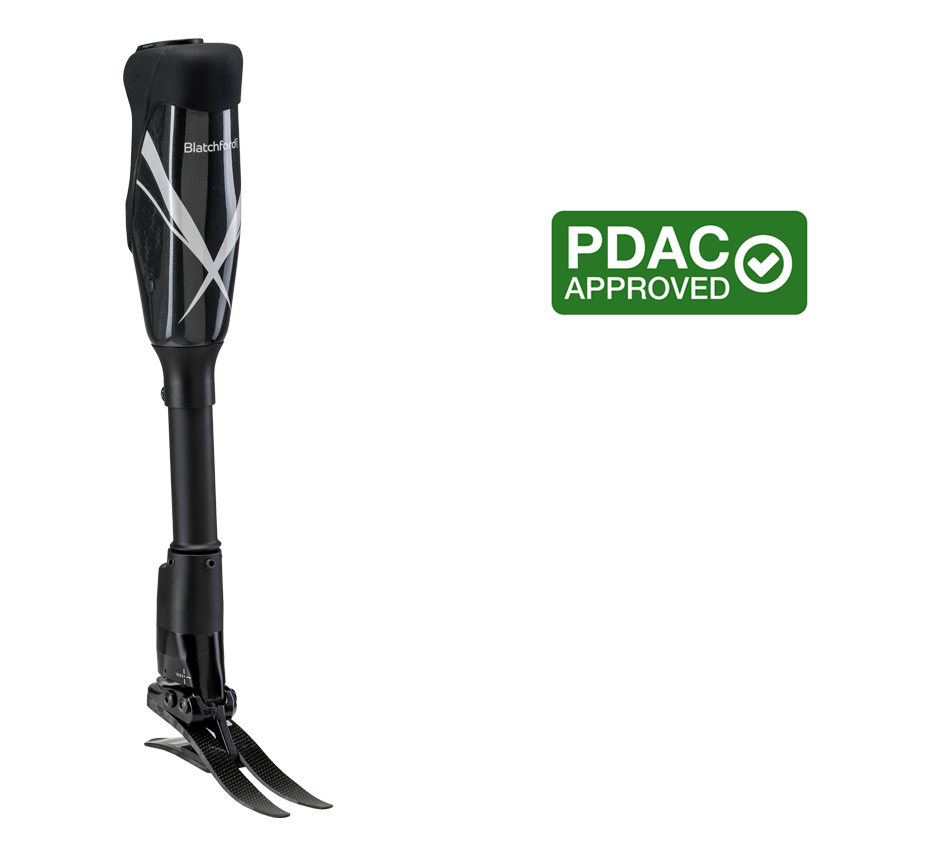Linx
Linx Limb System - Microprocessor-Controlled Prosthetic Leg - From Knee to Foot
Linx is the world’s only fully integrated limb system and winner of multiple awards for design and innovation.
Working as one Limb, Linx delivers an experience that mimics the incredible and complex structure of the human leg by actively sensing and analyzing data on the user movement, activity, environment and terrain providing a coordinated stream of instructions to the hydraulic support system.
The result is a walking experience that is closer to nature than ever before.

- Activity level 3
- Suitable for outdoor use
- Microprocessor control
- Bluetooth connectivity
The Completely Connected Limb
-
Continuous Communication
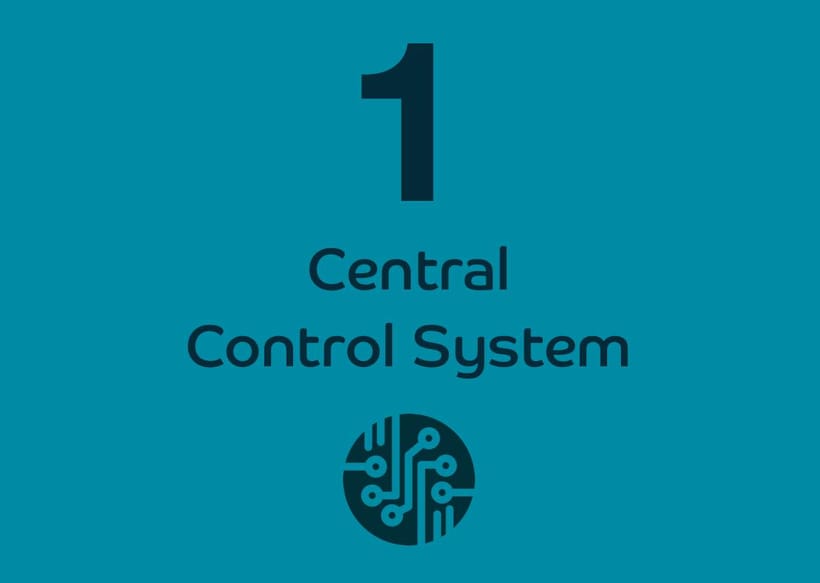
A single central control unit ensures you are connected and in control. Working alongside sensors and data collection points, this central unit allows the knee and ankle to function as one complete limb as nature intended.
-
Sensing As You Walk

Motion and load sensors continuously capture data on the activity, environment and terrain, the system recombines this data to anticipate actions and adapt the control response to move with the body seamlessly.
-
Ready For Your Next Step

The sensor’s input provides a continuous stream of data into the master control which co-ordinates the responses of the limb. This subtle response gives you the right amount of motion and stance control so you can move with confidence.
Precision Performance
Integrated sensors continually analyse data, adjusting the hydraulic technology to seamlessly align the leg for the next step. This integrated and coordinated limb response ensures fast adjustment times and easy navigation of slopes and steps, allowing the user to think about where they are going, rather than how they are going to get there.
-
Down Ramps
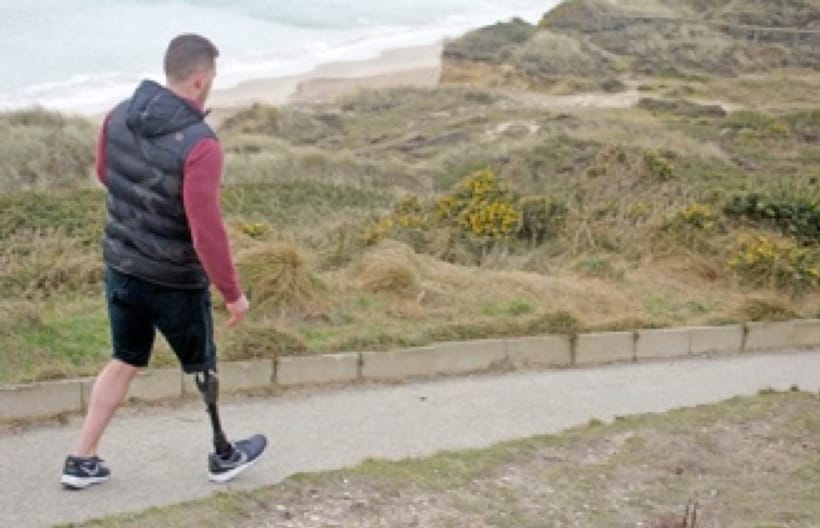
Linx delivers controlled ramp descent with different response levels for steep and shallow slopes. The knee and foot work together to optimise the rate of plantar-flexion and dorsi-flexion. The knee resistance is simultaneously adapted by introducing an intermediate resistance. On intermediate ramps, Linx offers a braking effect that secures the whole body for safe descent.
-
Up Ramps
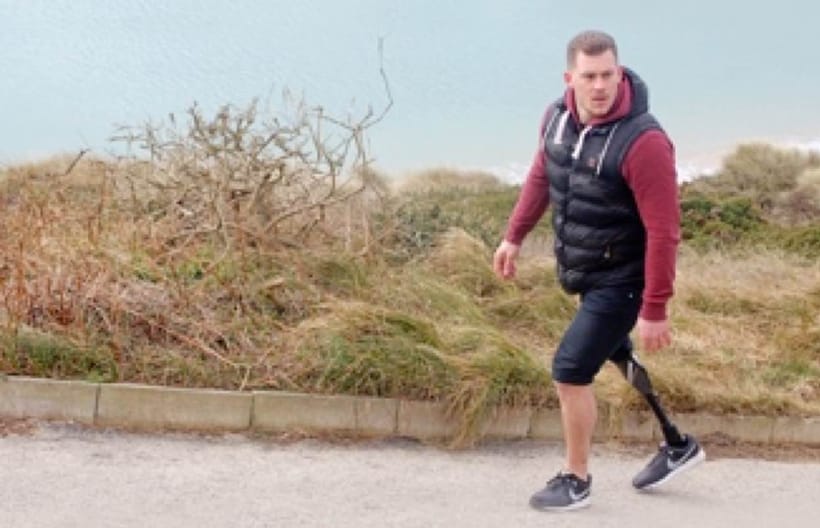
The knee and foot work in unison to dorsi-flex quickly. The toe remains dorsi-flexed for safe and efficient swing-through, while the heel stiffens to support the knee flexion. If stationary on a ramp, the toe will remain in dorsi-flexion to help reduce the extension moment on the knee, allowing a more upright posture for a more comfortable standing position.
-
Speed and Terrain
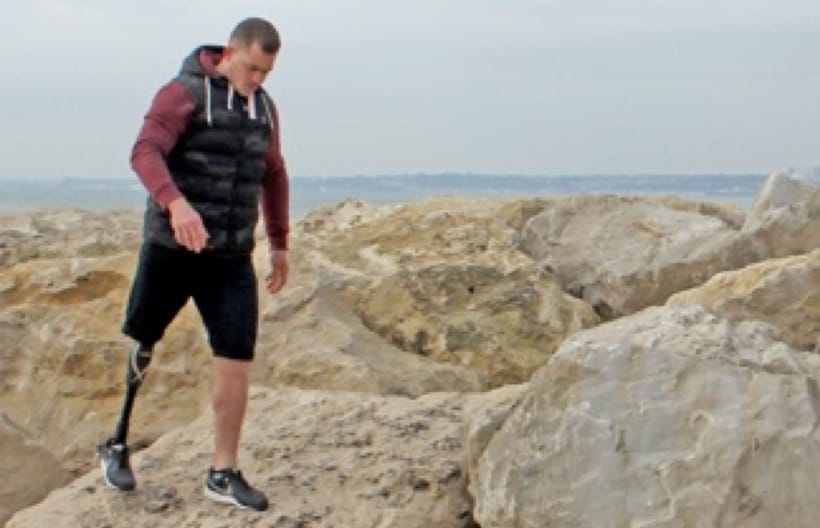
Additional synergies gained from simultaneous knee and foot programming, combined with the optimised control unit and hydraulic system means smoother transitions between speeds, and effortless progression over varied terrain.
Superior Comfort
Amputees can face health issues long after amputation, with lower limb amputees being 2-3 times more likely to develop osteoarthritis compared to the general population.1
Long term musculoskeletal health depends on the replication of the dynamic and adaptive qualities of natural limb movement, and Linx is the world’s first lower limb prosthesis to incorporate a completely integrated response system to serve this user need.
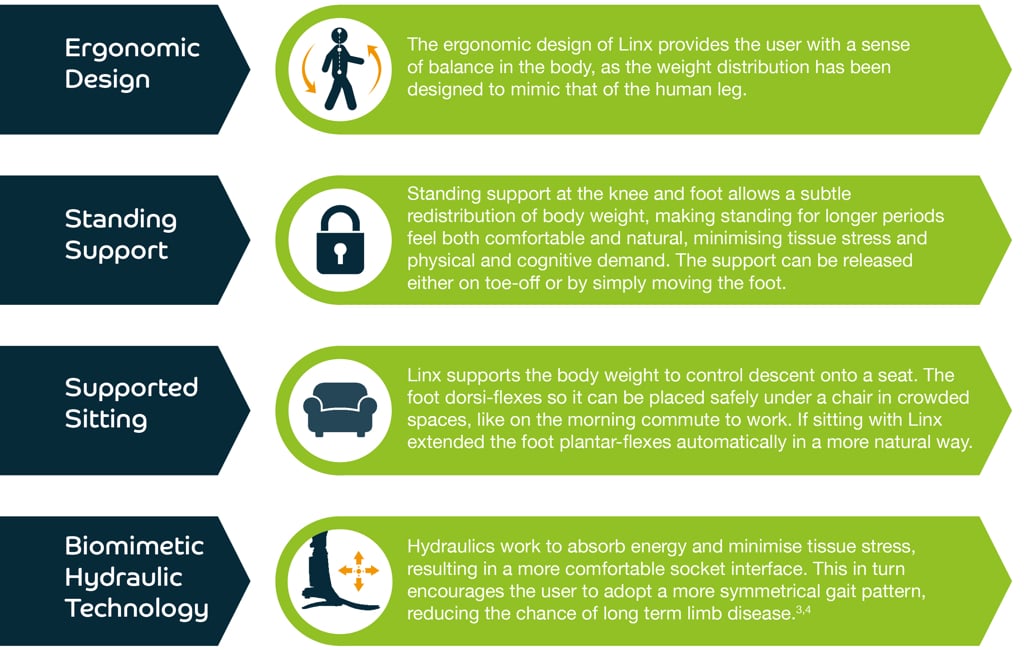
Exceptional Safety
The varying levels of stance support that Linx provides helps to increase the user’s confidence and independence, reducing the risk of stumbles or falls to help ensure more balanced limb loading for greater long term health and protection. Linx provides optimal stance support, whether walking in a crowded environment, on uneven terrain, slopes, steps or when standing. This unique combination of the integrated stance support and hydraulic technology within Linx contribute to the user’s safety.
-
Controlled Stance Support
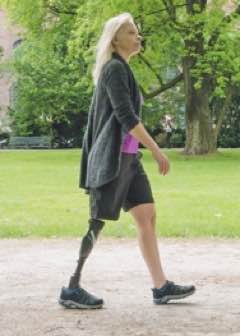
Supportive resistance throughout stance phase provides optimal stability for walking with greater safety and less effort on a variety of surfaces.
-
Standing Support
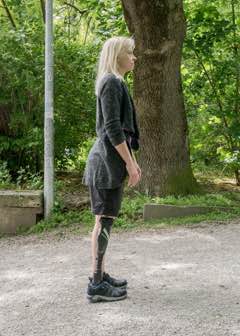
Maximum resistance stabilises knee and foot on both flat and sloped terrain, encouraging better posture and balanced loading to relieve pressure on the sound limb and lower back.
-
Stumble Recovery
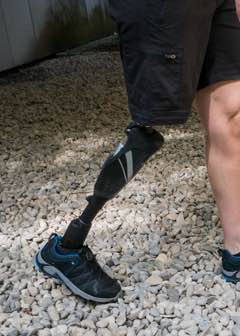
Stance resistance engages during swing phase extension to ensure knee stability, should the user stumble. Under such circumstances the flexion resistance dynamically increases to provide enhanced stumble recovery.
-
Dynamic Stair Descent
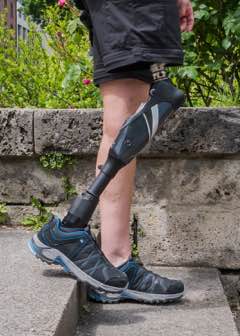
With immediate support from the first step, knee resistance progressively increases with knee flexion for enhanced control and safety when descending stairs.
-
Dynamic Slope Descent
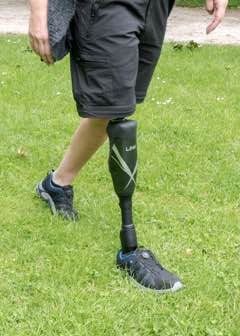
The integrated knee and foot response allows the user to walk leg-over-leg on intermediate slopes.
Real Life Linx Stories
Smart Programming App

Programming Linx just got faster and simpler with the new Linx Programming App for clinicians available on iOS and Android. With its simple to follow automated smart programming, you can complete limb set up with fewer steps whilst still having access to more advanced fine tuning if required.
This app is for clinicians who have completed a Blatchford approved training course and requires an authorisation code:
- Download the app from the App Store, search for “Linx programming”.
If using an iPad please choose “iPhone Only” when searching. - On first use, send the 8 digit “Authorisation Request Code” to your Blatchford representative.
- Enter the 12 digit code provided by your Blatchford representative into the app.
- Start programming Linx!
For support questions please contact Blatchford Technical Support at [email protected]
* Compatible with all models of iPad, iPhone and iPod Touch running iOS v9 or later.
Linx Clinical Evidence Reference
Improvements in Clinical Outcomes using Linx compared to mechanical knees
-
Safety
- Significantly reduced number of falls1,2
- Reduced centre-of-pressure fluctuations by 9-11% with standing support active when standing on sloped ground3
- Less cognitive demand during walking, leading to reduced postural sway4
-
Mobility
- Increased walking speed5
- Easier to walk at different speeds6
- Higher scores in mobility-related patient-reported outcome measures7
- More natural gait6,8
- Easier to walk on slopes6
-
Energy Expenditure
- Reduced energy expenditure compared to mechanical knees9-13
- Equivalent energy expenditure to other MPKs14
- Reduced self-perceived effort6,8
- Energy expenditure closer to that of able-bodied control subjects15
- Able to walk further before becoming tired6
-
Symmetry
- Better step length symmetry5
- Reduced loading asymmetry with standing support active when standing on sloped ground3
-
User satisfaction
- Reduced fear of falling1
- Reduced limitations due to an emotional problem8
- Preference over other prosthetic knees1,6
- Greater prosthetic confidence in slope descent and gait termination16
-
Health Economics
- Reductions in direct and indirect healthcare costs when using an MPK17
Improvements in Clinical Outcomes using Linx compared to ESR feet
-
Safety
Reduced risk of tripping and falls
- Increased minimum toe clearance during swing phase18,19
Improved knee stability on the prosthetic side during slope descent
- Increased mid-stance external prosthetic knee extensor moment20
Improving standing balance on a slope
- 24-25% reduction in mean inter-limb centre-of-pressure root mean square (COP RMS)3
-
Energy Expenditure
Reduced energy expenditure during walking
- Mean 11.8% reduction in energy use on level ground, across all walking speeds21
- Mean 20.2% reduction in energy use on slopes, across all gradients21
- Mean 8.3% faster walking speed for the same amount of effort21
-
Mobility
Improved gait performance
- Faster self-selected walking speed18,22-25
Improved ground compliance when walking on slopes
- Increased plantarflexion peak during level walking, fast level walking and cambered walking26
- Increased dorsiflexion peak during level walking, fast level walking and cambered walking26
Less of a prosthetic “dead spot” during gait
- Reduced aggregate negative COP displacement23
- Centre-of-pressure passes anterior to the shank statistically significantly earlier in stance23
- Increased minimum instantaneous COM velocity during prosthetic-limb single support phase23
- Reduced peak negative COP velocity25
- Reduced COP posterior travel distance25
Improved ground compliance when walking on slopes
- Increased plantarflexion range during slope descent19
- Increased dorsiflexion range during slope ascent19
Less effort on residual hip for trans-femoral amputees on varied terrains
- Reduced the mean hip extension and flexion moments27
Effects consistent over time
- Same gait variable changes in two gait lab sessions one year apart22
- Magnitude of changes comparable between sessions22
Brake mode during slope descent to control momentum build up
- Reduced mean prosthetic shank angular velocity in single support28
- Increased Unified Deformable Segment (prosthetic ‘ankle’) negative work28
Less gait compensation movements during slope descent
- Reduced residual knee flexion at loading response28
-
Residual Limb Health
Helps protect vulnerable residual limb tissue, reducing likelihood of damage
- Reduced peak stresses on residual limb29
- Reduced stress RMS on residual limb29
- Reduced loading rates on residual limb29
-
Loading Symmetry
Greater contribution of prosthetic limb to support during walking
- Increased residual knee peak extension moment22
- Decreased residual knee peak flexion moment22
- Increased residual knee negative work24
Reduced reliance on sound limb for support during walking
- Reduced intact limb peak hip flexion moment24
- Reduced intact limb peak dorsiflexion moment24
- Reduced intact ankle negative work and total work24
- Reduced intact limb total joint work24
Better symmetry of loading between prosthetic and sound limbs during standing on a slope
- Degree of asymmetry closer to zero for 5/5 amputees20
Reduced residual and sound joint moments during standing of a slope
- Significant reductions in both prosthetic and sound support moments30
Reduced residual joint moments during standing of a slope for bilateral amputees
- Significant reductions in prosthetic support moment30
- Permitted ‘natural’ ground reaction vector sagittal plane position, relative to knee joint centres30
Less pressure on the sole of the contralateral foot
- Peak plantar-pressure31
Improved gait symmetry
- Reduced stance phase timing asymmetry32
-
User satisfaction
Patient reported outcome measures indicate improvements
- Mean improvement across all Prosthesis Evaluation Questionnaire domains33
- Bilateral patients showed highest mean improvement in satisfaction33
Subjective user preference for hydraulic ankle
- 13/13 participants preferred hydraulic ankle31
Improvements in Clinical Outcomes using Linx compared to non-microprocessor-control hydraulic ankle-feet
-
Safety
Improved knee stability on the prosthetic side during slope descent
- Increased mid-stance external prosthetic knee extensor moment19
-
Mobility
Improved ground compliance when walking down slopes
- Reduced time to foot flat28
Brake mode during slope descent increases resistance to dorsiflexion to control momentum build up
- Reduced dorsiflexion range during slope descent19
- Reduced mean prosthetic shank angular velocity in single support28
- Increased Unified Deformable Segment (prosthetic ‘ankle’) negative work28
- Transition from dorsiflexion to plantarflexion moment occurs earlier in stance phase34
- Increase in mean prosthetic ‘ankle’ plantarflexion moment integral34
Assist mode during slope ascent decreases resistance to dorsiflexion to allow easier progression
- Transition from dorsiflexion to plantarflexion moment occurs later in stance phase34
- Decrease in mean prosthetic ‘ankle’ plantarflexion moment integral34
Less gait compensation movements during slope descent
- Reduced residual knee flexion at loading response28
-
Loading Symmetry
Greater reliance on prosthetic side for bodyweight support during slope descent
- Increased support moment integral34
Less reliance on sound side for bodyweight support during slope descent
- Decreased support moment integral34
Less reliance on sound side for bodyweight support during slope ascent
- Decreased support moment integral34
Reduced sound joint moments during standing of a slope
- Significant reductions in sound support moment30
Reduced residual joint moments during standing of a slope for bilateral amputees
- Significant reductions in prosthetic support moment30
- Permitted ‘natural’ ground reaction vector sagittal plane position, relative to knee joint centres30
-
User satisfaction
- Greater prosthetic confidence in slope descent and gait termination16
References
-
Full Reference Listing
-
Kaufman KR, Bernhardt KA, Symms K.
Functional assessment and satisfaction of transfemoral amputees with low mobility (FASTK2): A clinical trial of microprocessor-controlled vs. non-microprocessor-controlled knees. Clin Biomech 2018; 58: 116–122.
-
Campbell JH, Stevens PM, Wurdeman SR.
OASIS 1: Retrospective analysis of four different microprocessor knee types. Journal of Rehabilitation and Assistive Technologies Engineering. 2020 Nov;7:2055668320968476.
-
McGrath M, Laszczak P, Zahedi S, et al.
Microprocessor knees with ‘standing support’ and articulating, hydraulic ankles improve balance control and inter-limb loading during quiet standing. J Rehabil Assist Technol Eng 2018; 5: 2055668318795396.
-
Heller BW, Datta D, Howitt J.
A pilot study comparing the cognitive demand of walking for transfemoral amputees using the Intelligent Prosthesis with that using conventionally damped knees. Clin Rehabil 2000; 14: 518–522.
-
Chin T, Maeda Y, Sawamura S, et al.
Successful prosthetic fitting of elderly trans-femoral amputees with Intelligent Prosthesis (IP): a clinical pilot study. Prosthet Orthot Int 2007; 31: 271–276.
-
Datta D, Howitt J.
Conventional versus microchip controlled pneumatic swing phase control for trans-femoral amputees: user’s verdict. Prosthet Orthot Int 1998; 22: 129–135.
-
Wurdeman SR, Stevens PM, Campbell JH.
Mobility analysis of amputees (MAAT 3): Matching individuals based on comorbid health reveals improved function for above-knee prosthesis users with microprocessor knee technology. Assist Technol 2018; 1–7.
-
Saglam Y, Gulenc B, Birisik F, et al.
The quality of life analysis of knee prosthesis with complete microprocessor control in trans-femoral amputees. Acta Orthop Traumatol Turc 2017; 51: 466e469.
-
Chin T, Sawamura S, Shiba R, et al.
Energy expenditure during walking in amputees after disarticulation of the hip: a microprocessor-controlled swing-phase control knee versus a mechanical-controlled stance-phase control knee. J Bone Joint Surg Br 2005; 87: 117–119.
-
Datta D, Heller B, Howitt J.
A comparative evaluation of oxygen consumption and gait pattern in amputees using Intelligent Prostheses and conventionally damped knee swing-phase control. Clin Rehabil 2005; 19: 398–403.
-
Buckley JG, Spence WD, Solomonidis SE.
Energy cost of walking: comparison of “intelligent prosthesis” with conventional mechanism. Arch Phys Med Rehabil 1997; 78: 330–333.
-
Taylor MB, Clark E, Offord EA, et al.
A comparison of energy expenditure by a high level trans-femoral amputee using the Intelligent Prosthesis and conventionally damped prosthetic limbs. Prosthet Orthot Int 1996; 20: 116–121.
-
Kirker S, Keymer S, Talbot J, et al.
An assessment of the intelligent knee prosthesis. Clin Rehabil 1996; 10: 267–273.
-
Chin T, Machida K, Sawamura S, et al.
Comparison of different microprocessor controlled knee joints on the energy consumption during walking in trans-femoral amputees: intelligent knee prosthesis (IP) versus C-leg. Prosthet Orthot Int 2006; 30: 73–80.
-
Chin T, Sawamura S, Shiba R, et al.
Effect of an Intelligent Prosthesis (IP) on the walking ability of young transfemoral amputees: comparison of IP users with able-bodied people. Am J Phys Med Rehabil 2003; 82: 447–451.
-
Abdulhasan ZM, Scally AJ, Buckley JG.
Gait termination on a declined surface in trans-femoral amputees: Impact of using microprocessor-controlled limb system. Clin Biomech Bristol Avon 2018; 57: 35–41.
-
Chen C, Hanson M, Chaturvedi R, et al.
Economic benefits of microprocessor controlled prosthetic knees: a modeling study. J Neuroengineering Rehabil 2018; 15: 62.
-
Riveras M, Ravera E, Ewins D, Shaheen AF, Catalfamo-Formento P.
Minimum toe clearance and tripping probability in people with unilateral transtibial amputation walking on ramps with different prosthetic designs. Gait & Posture. 2020 Sep 1;81:41-8.
-
Johnson L, De Asha AR, Munjal R, et al.
Toe clearance when walking in people with unilateral transtibial amputation: effects of passive hydraulic ankle. J Rehabil Res Dev 2014; 51: 429.
-
Bai X, Ewins D, Crocombe AD, et al.
A biomechanical assessment of hydraulic ankle-foot devices with and without micro-processor control during slope ambulation in trans-femoral amputees. PLOS ONE 2018; 13: e0205093.
-
Askew GN, McFarlane LA, Minetti AE, et al.
Energy cost of ambulation in trans-tibial amputees using a dynamic-response foot with hydraulic versus rigid ‘ankle’: insights from body centre of mass dynamics. J NeuroEngineering Rehabil 2019; 16: 39.
-
De Asha AR, Barnett CT, Struchkov V, et al.
Which Prosthetic Foot to Prescribe?: Biomechanical Differences Found during a Single-Session Comparison of Different Foot Types Hold True 1 Year Later. JPO J Prosthet Orthot 2017; 29: 39–43.
-
De Asha AR, Munjal R, Kulkarni J, et al.
Impact on the biomechanics of overground gait of using an ‘Echelon’ hydraulic ankle–foot device in unilateral trans-tibial and trans-femoral amputees. Clin Biomech 2014; 29: 728–734.
-
De Asha AR, Munjal R, Kulkarni J, et al.
Walking speed related joint kinetic alterations in trans-tibial amputees: impact of hydraulic ’ankle’ damping. J Neuroengineering Rehabil 2013; 10: 1.
-
De Asha AR, Johnson L, Munjal R, et al.
Attenuation of centre-of-pressure trajectory fluctuations under the prosthetic foot when using an articulating hydraulic ankle attachment compared to fixed attachment. Clin Biomech 2013; 28: 218–224.
-
Bai X, Ewins D, Crocombe AD, et al.
Kinematic and biomimetic assessment of a hydraulic ankle/foot in level ground and camber walking. PLOS ONE 2017; 12: e0180836.
-
Alexander N, Strutzenberger G, Kroell J, et al.
Joint Moments During Downhill and Uphill Walking of a Person with Transfemoral Amputation with a Hydraulic Articulating and a Rigid Prosthetic Ankle—A Case Study. JPO J Prosthet Orthot 2018; 30: 46–54.
-
Struchkov V, Buckley JG.
Biomechanics of ramp descent in unilateral trans-tibial amputees: Comparison of a microprocessor controlled foot with conventional ankle–foot mechanisms. Clin Biomech 2016; 32: 164–170.
-
Portnoy S, Kristal A, Gefen A, et al.
Outdoor dynamic subject-specific evaluation of internal stresses in the residual limb: hydraulic energy-stored prosthetic foot compared to conventional energy-stored prosthetic feet. Gait Posture 2012; 35: 121–125.
-
McGrath M, Davies KC, Laszczak P, et al.
The influence of hydraulic ankles and microprocessor-control on the biomechanics of trans-tibial amputees during quiet standing on a 5° slope. Can Prosthet Orthot J; 2.
-
Moore R.
Effect of a Prosthetic Foot with a Hydraulic Ankle Unit on the Contralateral Foot Peak Plantar Pressures in Individuals with Unilateral Amputation. JPO J Prosthet Orthot 2018; 30: 165–70.
-
Moore R.
Effect on Stance Phase Timing Asymmetry in Individuals with Amputation Using Hydraulic Ankle Units. JPO J Prosthet Orthot 2016; 28: 44–48.
-
Sedki I, Moore R.
Patient evaluation of the Echelon foot using the Seattle Prosthesis Evaluation Questionnaire. Prosthet Orthot Int 2013; 37: 250–254.
-
McGrath M, Laszczak P, Zahedi S, et al.
The influence of a microprocessor-controlled hydraulic ankle on the kinetic symmetry of trans-tibial amputees during ramp walking: a case series. J Rehabil Assist Technol Eng 2018; 5: 2055668318790650.
-
Linx Documentation
-
Product Information
-
Linx Brochure
-
-
Other downloads
-
Linx - Ankle Alignment Wedge Instructions for Use
-
Linx - Cosmetic Cover Instructions for Use
-
Linx - Pylon Kit [Long]
-
Linx - Sandal Toe Foot Range Information
-
Linx - Linx Profile Form US Iss3
-
Linx PDAC Verification Letter
Suggested L-Codes: L5828, L5845, L5848, L5856, L5973 -
Blatchford Product L Codes January 2024
-
The PDAC-Approved badge denotes a product that has been approved by the Pricing, Data Analysis and Coding (PDAC) contractor for one or more of the prior authorization codes as specified in the Healthcare Common Procedure Coding System (HCPCS) codes.


